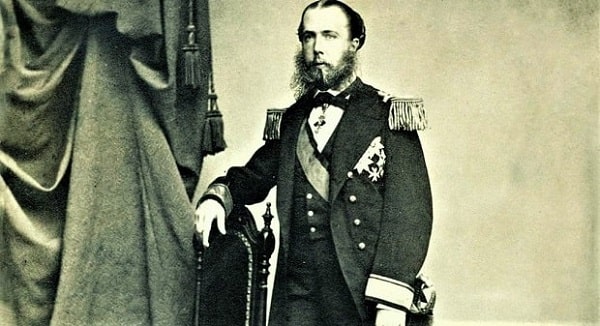
Maximilian (born Ferdinand Maximilian Joseph, on July 6, 1832, in Vienna, – died on June 19. 1867, in Querétaro City) was the only monarch of the Second Mexican Empire (1863-1867). He was the younger brother of Emperor Francis I of Austria.
After a distinguished career in the Austrian navy, he accepted Napoleon III’s offer from France to ascend to the Mexican throne. The French had invaded Mexico in the winter of 1861, as part of international armed intervention.
Trying to legitimize his dominance in part of the Americas, Napoleon III invited Maximilian to occupy the Mexican throne. He was supported by the French army and Mexican conservatives who were unhappy with President Benito Juárez’s liberal administration.
Maximiliano declared himself Emperor of Mexico on April 10, 1864. His reign did not last very long but was destabilized as liberal forces under the command of Benito Juarez Maximilian’s rule. Captured by Juarez’s men, it was executed in 1867.
Quick facts: Maximilian
- Known for: Emperor of Mexico
- Also known as: Ferdinand Maximilian Joseph Maria, Archduke Ferdinand Maximilian Joseph von Habsburg-Lorraine
- Born: July 6, 1832, in Vienna, Austria
- Parents: Archduke Franz Karl of Austria, Princess Sophie of Bavaria
- Died: June 19, 1867, in Santiago de Querétaro, Mexico
- Spouse: Charlotte of Belgium
- Notable quote: “Oh, God, I can be limited to the point, and I for a king of infinite space, it wasn’t that I have bad dreams.”
The Early Life of Maximilian
Maximilian was born in the Schonbrunn Palace on July 6, 1832, in the Austrian capital. It was the second son of Archduke Franz Karl and Princess Sophie of Bavaria. However, it is rumored that Maximilian was actually the biological son of Napoleon II (died 1832), son of Napoleon Bonaparte, and his second wife, Maria Luisa from Austria.
Sofia and Napoleon II, titled as Duke of Reichstadt, had an intimate friendship that provoked rumors at court, which the archduchess never bothered to deny. When she became pregnant a second time, Napoleon II died of tuberculosis.
In Trieste, Maximilian was a sailor for several years, living for a long time on the high seas; collaborated in the triumph of his nation in the war against Italy. Having met Princess Maria Amélia of Brazil, daughter of Pedro I of Brazil (IV of Portugal) and Amélie of Leuchtenberg, he would have planned marriage, but Maria Amélia died early on the island of Madeira, in 1853.
Of mourning with this loss, Maximilian began to use a ring containing one bunch of the hair of the late Princess.
On July 27, 1857, Maximilian contracted marriage with Charlotte of Belgium, the only daughter of King Leopold I of Belgium. The marriage, however, only occurred for economic reasons, as he urgently needed money to pay his debts for the construction of Miramare Castle in Trieste, on the Adriatic coast. For that, he used Carlotta’s dowry.
Leopold I of Belgium pressured the emperor Franz Joseph I of Austria, brother of his son-in-law, to grant Maximilian the position of viceroy of the Lombardo-Veneto Kingdom. Thus, he would complete his dynastic ambitions for his daughter.
They then lived in the city of Milan until 1859, when the emperor withdrew him from the post because the war plans were not in Maximilian’s liberal ideals. Little by little, Austria-Hungary lost its possessions in Italy, and the archduke decided to withdraw from public life in his Miramare castle.
Emperor of Mexico
Maximilian and Charlotte arrived in Mexico in May 1864 and officially resided at Chapultepec Castle. Maximilian inherited a very unstable nation. The conflict between conservatives and liberals, who had caused the Reform War, still simmered and Maximilian was not able to unite the two factions.
He annoyed his conservative supporters by adopting some liberal reforms and his attempts at rapprochement with liberal leaders were spurned. Benito Juarez and his liberal followers grew in force, and there was little Maximilian could do about it.
With the end of the American Civil War, the United States government began to pressure France to withdraw from Mexico. In 1866, French forces began evacuating and Napoleon III advised Maximilian to abdicate and escape, which he refused. Maximilian found himself in an increasingly uncertain position.
However, even without internal or external support, he personally took charge of his soldiers and tried to resist, but failed to turn the tide of conflict against Republicans. After a siege in Santiago de Querétaro, he was captured, imprisoned, tried by a court-martial and shot together with his generals Tomás Mejía Camacho and Miguel Miramón.
With his death, the claim to the Mexican throne was claimed by two distinct branches. The House of Iturbide, by the adoption of the grandchildren of the first emperor of Mexico Agustin de Itúrbide, and another branch the Habsburg-Gueroult.
Maximilian ruled Mexico for less than four years from Chapultepec Castle. He tried to implement liberal policies, which alienated his conservative support base. He tried to finance houses for the poorest, forgave peasants’ debts, reduced the people’s working hours, and also banned child labor.
Although he tried to implement populist reforms, he never ended up being popular with the Mexican people and many celebrated his death, especially the Republicans. His assessment of historians is controversial, with many praising him for his reforms and others condemning him as an ineffective politician.
Maximilian Death
Mexico City fell to liberal forces in early 1867, and Maximilian retired to Querétaro city, where he and his men survived several weeks before being given a siege. Captured, Maximilian was executed along with two of his generals on June 19, 1867.
He was 34 years old. His body was returned to Austria the following year, where he is currently in the Capuchin Crypt in Vienna.